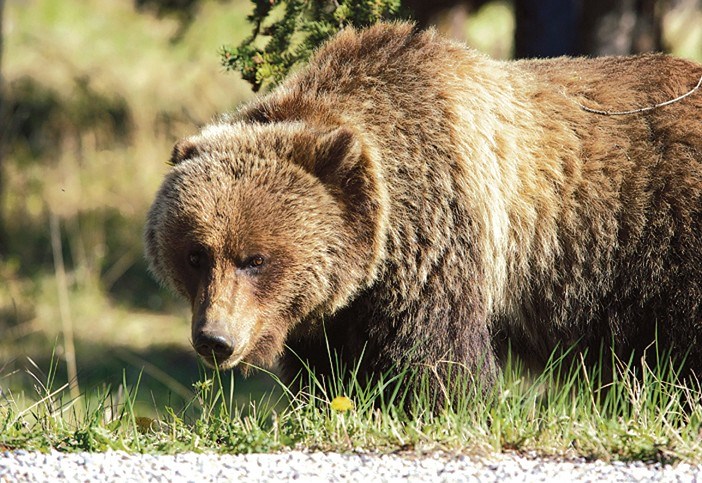BANFF – Grizzly bears are being counted on provincial lands east of Banff and Jasper national parks to give the Alberta government updated information in order to eventually reevaluate the status of the threatened species.
This year, fRI Research is doing DNA counts on grizzly bear populations in three areas of the province, including bear management unit four east of Banff National Park between Highway 1 and Highway 22.
Because grizzly bears have been listed as threatened in Alberta since 2010 when DNA counts determined there were about 700 grizzlies remaining, officials say it’s important to monitor their numbers to see if conservation efforts are working.
Gordon Stenhouse, research scientist and program lead with fRI’s grizzly bear program, said grizzly bear surveys have been done in most regions and those that haven’t should be completed by spring 2019.
He said the last time bears were counted in BMA 4 was in 2005, noting the same methodology and sampling design is being used for the updated count.
“At the time, there was a point estimate of 46 animals,” said Stenhouse, adding fRI Research is also counting bears around Slave Lake and Whitecourt and a portion of the foothills east of Jasper National Park.
“All this work will allow the provincial government to move forward with a new status evaluation of grizzly bears.”
In the meantime, the Alberta government has indicated a long-awaited plan to help grizzly bears and their habitat is to be sent to the Endangered Species Conservation Committee for review later this month.
No details are being released by Alberta Environment and Parks at this stage.
The grizzly bear program run by fRi Research – a not-for-profit research organization – will gather DNA from bears non-invasively by setting up “scent lures” surrounded by a strand of barbed wire.
When curious bears investigate the smell, they rub against the wire and leave tufts of hair. Hair is sent off to a lab for DNA analysis, which identifies individual bears and estimates the population size.
The fieldwork will wrap up at the end of July. Lab results are expected by early 2019, at which time researchers will crunch the numbers and write up the results for later that year.
There was interest in updating the numbers, including for BMA 3 east of Jasper, where the grizzly bear population almost doubled in 10 years, going from 42 in 2004 to 76 in 2014.
Stenhouse said they’re still examining possible reasons behind the population increase in that region.
“A couple of things happened. For example, in 2006 sport hunting of grizzly bears stopped in Alberta and that eliminated one form of human-caused mortality,” he said.
“We also continue to move conflict or problem bears and we move bears into other management units, and we think some of the population increase is related to relocating bears.”
Stenhouse said humans continue to change the landscape, noting prescribed burns can improve bear habitat by creating more bear food, such as berries.
“Forestry harvesting is another one and can affect ungulate opportunities, which are bear food and bears respond to that and it can lead to more cubs being born,” he said.
Stenhouse said one of the biggest challenges is getting a handle on the number of bears killed by poachers.
“We don’t know how that has been doing in MBA 4 and that is a concern to us,” he said.
In addition, technological and science advances in DNA analysis since bear counting began in 2005 also helps researchers understand more about bear populations.
Stenhouse said back then only only individuals and the sex of the bear could be confirmed.
“We are now able to learn from hair more than ever before. Now we can tell relatedness, we can tell if they’re offspring, we can tell whether a bear is an adult or sub-adult,” he said.
“The other thing we can get if there’s a large enough sample of hair, is to understand reproductive hormone levels so we can tell whether a female is pregnant and whether she has cubs.”
A DNA survey for BMA 5 – from the Trans-Canada Highway south to the Crowsnest Pass, which includes Canmore and Kananaskis Country, revealed grizzly bear numbers in this region are stable, perhaps slightly increasing.
There’s an estimated 16 grizzlies per 1,000 square kilometres in the northern portion of BMA5, which takes in K-Country, and 12 grizzly bears per 1,000 sq. km. in the southern region.
Based on DNA results and modeling programs, researchers have come up with an estimate of 96 grizzlies – 52 females and 43 males – in the 6,000 sq. km. northern section and approximately 35 bears – 22 females and 12 males – in the south.
“The population is stable, or slightly increasing,” said John Paczkowski, an ecologist with Alberta Environment and Parks at a recent public presentation. “What’s interesting since the last census is that the population is expanding eastward.”




